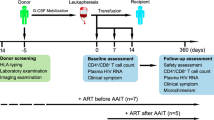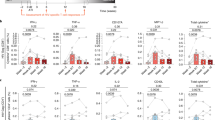Summary:
Advances in effective antiretroviral therapy for HIV infection have made high-dose therapy and autologous stem cell transplantation possible in patients with HIV-associated lymphomas. Regimen-related toxicity is not significantly increased when antiretroviral therapy is combined with high-dose chemoradiotherapy. Durable engraftment can be seen with autologous stem cell rescue. Infectious complications can be managed with a combination of surveillance and prophylaxis. Long-term remissions of these high-risk lymphomas can be achieved with this approach. This suggests that patients with HIV-associated lymphomas should be considered for autologous transplantation in a manner similar to HIV-negative lymphoma patients
This is a preview of subscription content, access via your institution
Access options
Subscribe to this journal
Receive 12 print issues and online access
$259.00 per year
only $21.58 per issue
Buy this article
- Purchase on Springer Link
- Instant access to full article PDF
Prices may be subject to local taxes which are calculated during checkout


Similar content being viewed by others
References
Roland ME, Stock PG . Review of solid-organ transplantation in HIV-infected patients. Transplant 2003; 75: 425–429.
Revision of the case definition of acquired immunodeficiency syndrome for national reporting – United States. MMWR 1985; 34: 373–375.
Levine AM . Hodgkin's disease in the setting of human immunodeficiency virus infection. J Natl Cancer Inst Monogr 1998; 23: 37–42.
Levine AM . Acquired immune deficiency syndrome related lymphoma; clinical aspects. Semin Oncol 2000; 27: 442–453.
Senerviratne L, Espina BM, Nathwani BN et al. Clinical, immunologic and pathologic correlates of bone marrow involvement in 291 patients with acquired immunodeficiency syndrome related lymphoma. Blood 2001; 98: 2358–2363.
Tirelli U, Errante D, Dolcetti R et al. Hodgkin's disease and immunodeficiency virus infection; clinicopathologic and virologic features of 114 patients from the Italian Cooperative Group on AIDS and Tumours. J Clin Oncol 1995; 13: 1758–1767.
Straus DJ, Juang J, Testa MA et al. Prognostic factors in the treatment of HIV associated non-Hodgkin's lymphoma: analysis of the AIDS Clinical Trials Group protocol 142: low dose versus standard dose m-Bacod plus GMCSF. J Clin Oncol 1998; 16: 3601–3606.
Navarro JT, Ribera JM, Oriol A et al. International prognostic index is the best prognostic factor for survival in patients with AIDS related non-Hodgkin's lymphoma treated with CHOP. A multivariate study of 46 patients. Haematologica 1998; 83: 508–513.
Kaplan LD, Straus DJ, Testa MA et al. Low-dose compared with standard dose m-BACOD chemotherapy for non-Hodgkin's lymphoma associated with human immunodeficiency virus infection. N Engl J Med 1997; 336: 1641–1648.
Oksenhendler E, Gerard L, Dubreuil ML et al. Intensive chemotherapy (LNHIV 91 regimen) and GCSF for HIV associated non-Hodgkin's lymphoma. Leukemia Lymphoma 2000; 39: 87–95.
Levine AM, Li P, Cheung T et al. Chemotherapy consisting of DTIC with G-CSF in HIV infected patients with newly diagnosed Hodgkin's disease: a prospective multiinstitutional AIDS clinical trial group study (ACTG 149). J Acquir Immune Defic Syndr 2000; 24: 444–450.
Tirelli U, Errante D, Spina M et al. Second line chemotherapy in HIV related non-Hodgkin's lymphoma. Cancer 1996; 77: 2127–2131.
Bi J, Espina BM, Tulpule A et al. High dose cytosine arabinoside and cisplatin regimens as salvage therapy for refractory or relapsed AIDS related non-Hodgkin's lymphoma. J Acquir Immune Defic Syndr 2001; 28: 416–421.
Palella FJ, Delaney KM, Moorman AC et al. Declining morbidity and mortality among patients with advanced human immunodeficiency virus infection. HIV outpatient study investigators. N Engl J Med 1998; 338: 853–860.
Sparano JA, Anand K, Desai J et al. Effect of highly active antiretroviral therapy on the incidence of HIV associated malignancies at an urban medical center. J Acquir Immune Defic Syndr 1999; 21: s18–s22.
Mocroft A, Katama C, Johnson AM et al. AIDS across Europe 1994–1998. The Euro SIDA Study. Lancet 2000; 356: 291–296.
Appleby P, Beral V, Newton R et al. nternational collaboration on HIV and cancer: highly active antiretroviral therapy and incidence of cancer in human immunodeficiency infected adults. J Nat Cancer Inst 2000; 92: 1823–1830.
Ratner L, Lee J, Tang S et al. Chemotherapy for HIV associated non-Hodgkin's lymphoma in combination with highly active antiretroviral therapy. J Clin Oncol 2001; 19: 2171–2178.
Vaccher E, Spina M, Santarossa S et al. Concomitant CHOP chemotherapy and highly active antiretroviral therapy in patients with HIV related non-Hodgkin's lymphoma. Int Conf AIDS Geneva 1998; 320 (abstr. 22289).
Sparano J, Wiernik P, Hux et al. Pilot trial of saquinavir and nucleoside analogues plus infusional cyclophosphamide, doxorubicin and etoposide in patients with HIV associated NHL. Second National AIDS Malignancy Conference, Bethesda, MD, 1998, (abstr. 78).
Weiss R, Mitrou P, Keikawus A et al. HIV related lymphoma: HAART parallel to CHOP chemotherapy is safe and improves survival. Blood 2001; 98 (abstr. 1463) p 347a.
Spina M, Gabarre J, Rossi G et al. Stanford V regimen and concomitant HAART in 59 patients with Hodgkin disease and HIV infection. Blood 2002; 100: 1984–1988.
Little R, Pittaluga S, Grant N et al. Highly effective treatment of acquired immunodeficiency syndrome-related lymphoma with close-adjusted EPOCH: Impact of antiretroviral therapy suspension and tumor biology. Blood 2003; 101: 4653–4659.
Phillip T, Gugliermi C, Hagenbeek A et al. Autologous bone marrow transplantation as compared with salvage chemotherapy in relapses of chemotherapy sensitive non-Hodgkin's lymphoma. N Engl J Med 1995; 333: 1540–1545.
Haioun C, Lepage E, Gisselbrecht et al. Survival benefit of high dose therapy in poor risk aggressive non-Hodgkin's lymphoma. J Clin Oncol 2000; 18: 3025–3030.
Linch DC, Winfield D, Goldstone AH et al. Dose intensification with autologous bone marrow transplantation in relapsed and resistant Hodgkin's disease: results of a BNL1 randomized trial. Lancet 1993; 341: 1051–1054.
Nademanee A, Molina A, Dagis A et al. Autologous stem cell transplantation for poor risk and relapsed intermediate and high grade non-Hodgkin's lymphoma. Clin Lymphoma 2000; 1: 46–54.
Koka PS, Jamieson BD, Brooks DG, Zack J . Human immunodeficiency virus type 1 induced hematopoietic inhibition is independent of productive infection of progenitor cells in vivo. J Virol 1999; 73: 9089–9097.
Bahner I, Kearns K, Coutinho S et al. Infection of human immunodeficiency virus is both required and sufficient for HIV 1 induced hematopoietic suppression in vitro: demonstration by gene modification of primary human stroma. Blood 1997; 90: 1787–1798.
Huang SS, Barobour JD, Deeks SG et al. Reversal of human immunodeficiency virus type 1 associated hematosuppression by effective antiretroviral therapy. Clin Infect Dis 2000; 30: 504–510.
Junker U, Moon JJ, Sniecinscki I et al. HIV Status and function of GCSF mobilized peripheral blood hematopoietic stem cells from asymptomatic HIV 1 infected individuals: implications for anti-HIV gene therapy. Blood 1996; 88 (abstr. 1074) p 271a.
Ragni MV, Dodson SF, Hunt SC et al. Liver transplantation in a hemophilia patient with acquired immunodeficiency syndrome. Blood 1999; 93: 1113–1114.
Gabarre J, Choquet S, Azar N et al. High dose chemotherapy with autologous stem cell transplantation for HIV associated lymphoma; a single center report on 14 pts. Blood 2001; 98 (abstr. 2092) p 502a.
Kang E, de Witte M, Malech H et al. Nonmyeloablative conditioning followed by transplantation of genetically modified HLA matched peripheral blood progenitor cells for hematologic malignancies in patients with acquired immunodeficiency syndrome. Blood 2002; 99: 698–701.
Serrano D, Carrion R, Miralles P et al. G-CSF 10 μg/kg/12 h × 5 d mobilizes enough CD34+ peripheral blood cells to perform an autologous stem cell transplant (ASCT) in HIV-1+high risk lymphoma pts without increasing HIV-1 copies. Blood 2001; 98 (abstr. 2840) p 679a.
Campbell P, Lland H, Gibson J, Joshua D . Syngeneic stem cell transplantation for HIV-related lymphoma. Br J Hematol 1999; 105: 795–798.
Bowden R, Coombs R, Nikora B et al. Progression of human immunodeficiency virus type 1 infection after allogeneic marrow transplantation. Am J Med 1990; 88: 49–52.
Krishnan A, Molina A, Forman SJ . Organ transplantation in HIV-infected patients. N Eng Med 2002; 347: 1802.
Acknowledgements
We thank Dr David Smith and Jason Chapman, CRA for statistical support, Diana Garcia for manuscript preparation, Debra Vasquez, RN for transplant coordination and the clinical staff in the Division of Hematology and Bone Marrow Transplantation at the City of Hope.
This work was supported in part by United States Public Health Science Grants CA 30206, CA 33572, A138592, and Grant MO1-RR-43 from the General Clinical Research Center branch of the National Center for Research Resources, National Institutes of Health. AK is the recipient of a Lymphoma Research Foundation of America award.
Author information
Authors and Affiliations
Corresponding author
Rights and permissions
About this article
Cite this article
Krishnan, A., Zaia, J. & Forman, S. Should HIV-positive patients with lymphoma be offered stem cell transplants?. Bone Marrow Transplant 32, 741–748 (2003). https://doi.org/10.1038/sj.bmt.1704270
Published:
Issue Date:
DOI: https://doi.org/10.1038/sj.bmt.1704270
Keywords
This article is cited by
-
Autologous stem cell transplantation for lymphoma in HIV+ patients: higher rate of infections compared with non-HIV lymphoma
Bone Marrow Transplantation (2020)
-
A prognostic score for AIDS-related diffuse large B-cell lymphoma in Brazil
Annals of Hematology (2010)
-
Successful unrelated bone marrow transplantation for a human immunodeficiency virus type-1-seropositive acute myelogenous leukemia patient following HAART
International Journal of Hematology (2010)
-
Unrelated cord blood transplantation for a human immunodeficiency virus-1-seropositive patient with acute lymphoblastic leukemia
Bone Marrow Transplantation (2005)



